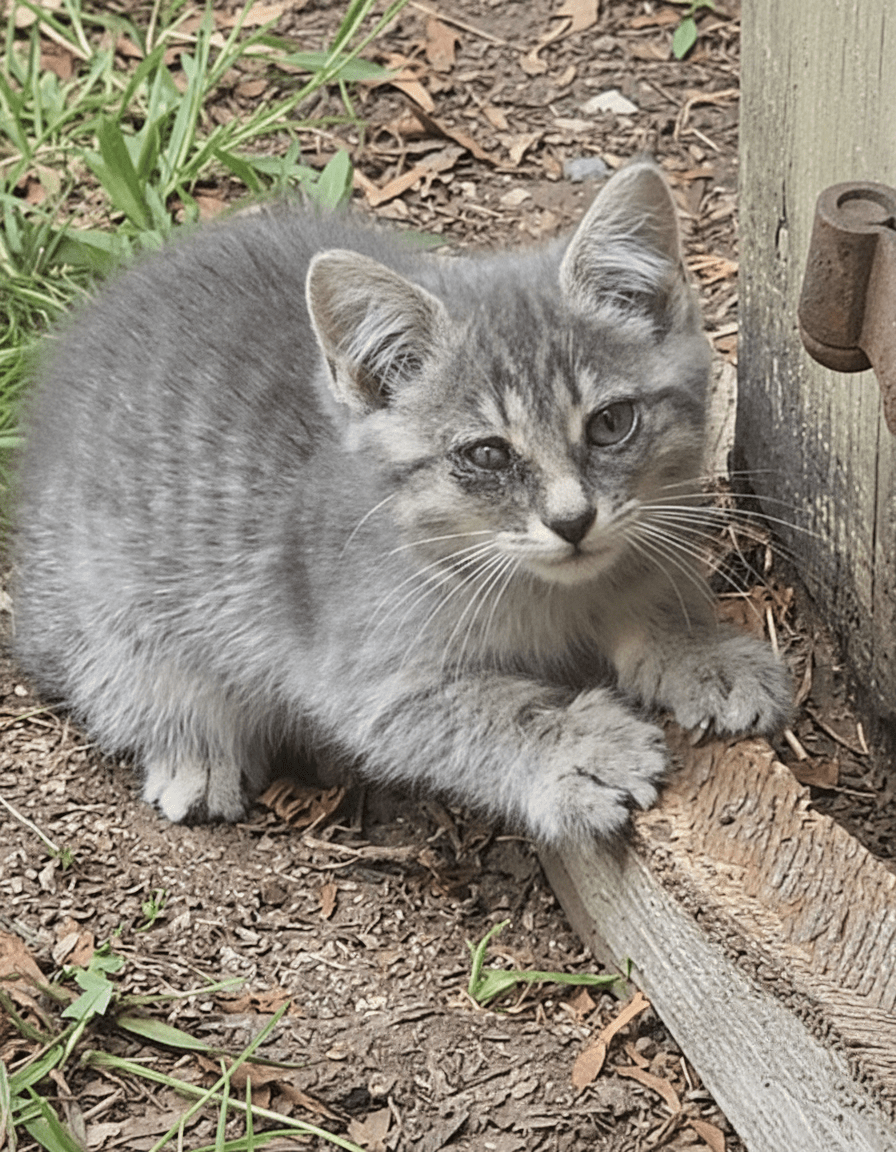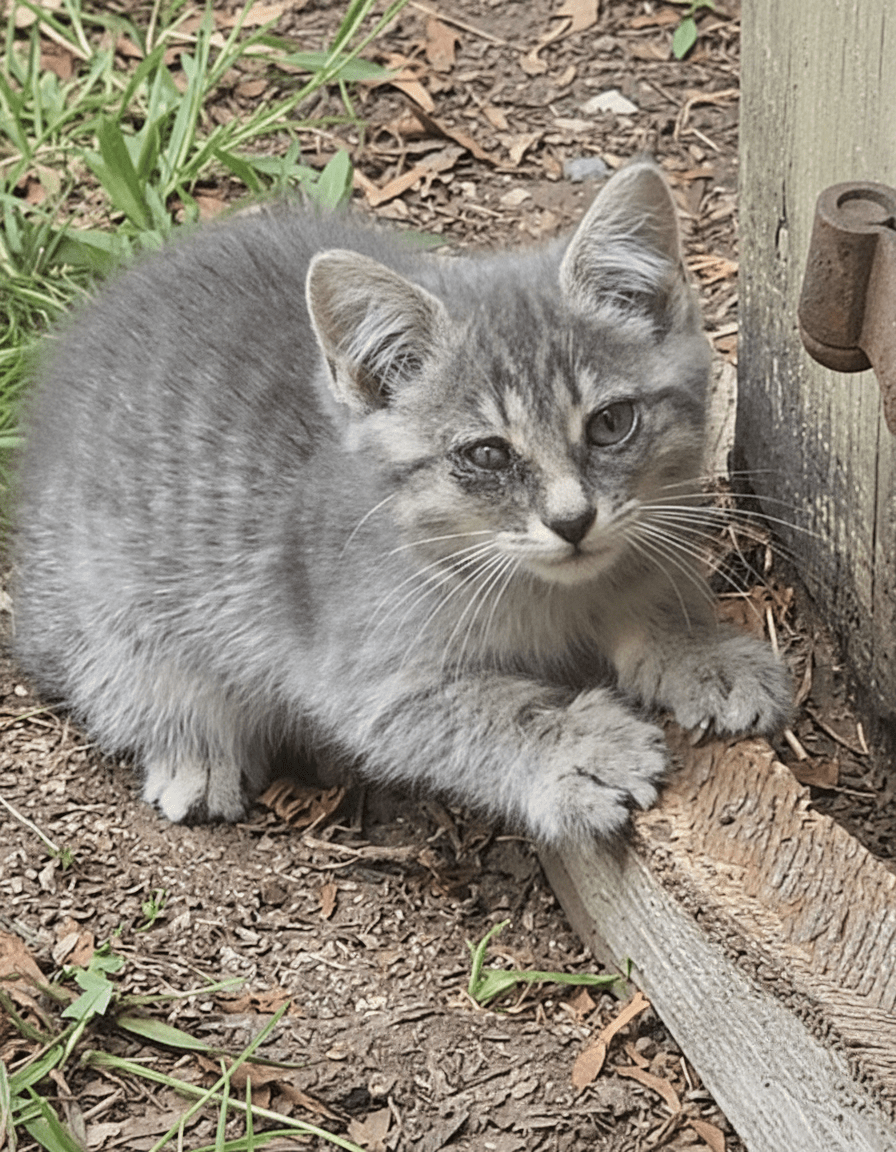In the quiet, overgrown corners of rural Lawrence County, Kentucky, where abandoned barns lean under the weight of kudzu and the hum of cicadas drowns out distant traffic, a tiny gray tabby kitten named Winky entered the world on a rain-soaked April night in 2025. Born beneath a rusted tractor in a feral cat colony of nearly thirty animals, she was one of five siblings delivered by a skittish silver mother who had evaded traps for three seasons. The colony thrived—or rather, survived—on the edge of a 19th-century farmstead turned junkyard, where locals dumped old appliances and forgotten dreams. Here, amid shattered glass and poison ivy, Winky opened her mismatched eyes: one a cloudy, infected blue, the other a sharp emerald green. From her first breath, survival was never guaranteed. Her mother, known to caregivers only as “Ghost,” licked her clean but offered little warmth; the runt of the litter, Winky weighed barely six ounces, her ribs visible beneath damp fur. What followed was a chain of improbable events—near-death escapes, a volunteer’s midnight vigil, a veterinarian’s 3 a.m. surgery, and a community’s quiet rebellion against despair—that transformed a doomed street kitten into a symbol of second chances.

The colony had been monitored for years by Marlene Whitaker, a 62-year-old retired school bus driver who funded her TNR (trap-neuter-return) efforts with yard-sale proceeds and GoFundMe campaigns that rarely exceeded $200. Every dawn, Marlene arrived in her dented Ford Ranger, hauling cans of Friskies and jugs of bleach water. She knew each cat by sight: Tripod, the three-legged tom; Patches, the calico with half a tail; and Ghost, who always hissed but never bit. Winky, however, was new. Marlene first spotted her in late July, limping behind her mother with a swollen left eye weeping yellow pus. The kitten’s mew was barely audible over the drone of grasshoppers. Marlene set a drop trap baited with rotisserie chicken, but Winky—despite her frailty—darted into a drainage pipe slick with motor oil. For six weeks, the game continued. Marlene logged 14 failed attempts, each more creative than the last: sardine juice trails, laser pointers, even a Bluetooth speaker playing kitten distress calls recorded from YouTube. Neighbors began leaving notes on her windshield—“Try tuna in spring water, not oil”—turning the rescue into a bizarre communal obsession.
By mid-September, Winky’s condition deteriorated dramatically. The infected eye had ruptured, leaving a crater of raw tissue; her weight plummeted to 1.2 pounds. She could no longer climb the scrap-metal piles to reach her mother’s milk. Marlene found her one Thursday morning collapsed beside a discarded microwave, flies swarming the wound. This time, Winky didn’t run. Marlene wrapped her in a threadbare University of Kentucky towel—donated by a fan at last year’s yard sale—and drove 47 miles to the Lawrence County Humane Society, a cinder-block shelter built in 1987 with a leaky roof and a staff of three. Shelter manager Dana Perkins, who had euthanized 42 cats that month due to overcrowding, took one look at Winky and made a call that broke protocol: she authorized emergency transport to Bluegrass Veterinary Specialists in Lexington, a 90-minute drive usually reserved for police K9s and prize-winning racehorses.
At 11:47 p.m., Dr. Elias Grant, a 34-year-old ophthalmology resident on his third coffee, met Winky in the ER. The kitten’s temperature was 94.6°F; her white blood cell count topped 28,000. X-rays revealed a surprise: a BB pellet lodged in her sinus cavity, likely fired by a teenager with a wrist rocket months earlier. The pellet had migrated, causing chronic sinusitis that exacerbated the eye infection. “This isn’t just entropion or herpesvirus,” Dr. Grant told the shelter’s overnight tech. “This is a war zone.” Surgery was scheduled for 3:00 a.m.—enucleation of the left eye, pellet extraction, and placement of a subcutaneous fluid port for aggressive IV therapy. The procedure lasted 94 minutes. Dr. Grant removed the eye, irrigated the orbit with vancomycin-laced saline, and closed the socket with dissolvable sutures. He kept the BB pellet in a specimen jar labeled “Winky—Evidence of Human Stupidity.”
Post-op, Winky spent 72 hours in an oxygen cage normally used for brachycephalic dogs. Volunteers rotated shifts, reading her chapters from The Secret Life of Cats in soothing voices. A local radio station, 98.5 The Cat, launched a “Winky Watch” segment, complete with a GoFundMe that raised $4,200 in 48 hours—enough to cover surgery, a month of antibiotics, and a lifetime supply of lysine treats. But the surprises kept coming. Genetic testing, funded by an anonymous donor who turned out to be a UK basketball player’s grandmother, revealed Winky carried the rare “W” gene for white spotting, explaining her odd-colored eyes. More shockingly, her mother Ghost was trapped two days later and tested positive for FIV—but Winky, somehow, remained negative. “She’s a statistical unicorn,” Dr. Grant marveled.
Recovery was not linear. On day five, Winky developed a fever spike to 105°F; cultures grew Pseudomonas resistant to everything except colistin, a last-resort antibiotic banned in food animals. The shelter’s board debated euthanasia, but Dana refused, citing the public outpouring. Instead, they crowdsourced colistin from a retired pharmacist in Ohio who mailed it overnight in a cooler marked “Seafood.” Winky responded within 36 hours. By week three, she was batting at feather toys with her remaining eye, her depth perception already adapting. Marlene visited daily, bringing rotisserie chicken and whispering apologies for the weeks of failed traps.
The shelter’s adoption counselor, 19-year-old Kaylee Moore, began socialization sessions in a converted storage room painted with murals of cartoon mice. Winky, initially hissing at reflections, learned to head-butt Kaylee’s chin within days. She discovered a passion for Churu puree licked from a syringe and an inexplicable hatred of ceiling fans. A viral TikTok—Winky “boxing” a stuffed octopus—garnered 2.3 million views, with comments ranging from “Adopt her NOW” to “Name her Pirate Queen.” The shelter fielded 187 applications, including one from a children’s hospital in Cincinnati seeking a therapy cat. They chose instead a quiet couple from Louisa—both veterans with PTSD—who promised Winky a sunroom overlooking the Big Sandy River.
On November 10, 2025, Winky—now 2.8 pounds, spayed, microchipped, and sporting a tiny eyepatch embroidered with a skull—left the shelter in a carrier lined with a quilt sewn from Marlene’s old bus-seat upholstery. Her medical file, thick as a phone book, included a note from Dr. Grant: “Prognosis: Excellent. Spirit: Indomitable.” The colony where she was born still exists, but Ghost now wears a tipped ear and eats from a heated bowl Marlene built from a repurposed crockpot. Tripod and Patches watch over four new kittens, none of whom will ever know the hunger Winky endured.

Winky’s story is not unique—similar miracles unfold daily in shelters from rural Kentucky to suburban California—but her journey illuminates the fragile alchemy of rescue: one exhausted volunteer, one overworked vet, one viral video, one pellet in a jar. She is proof that even the smallest, most broken creatures can rewrite their endings. As she naps in her new sunroom, one eye forever closed but the other wide to a world that finally sees her, Winky embodies a truth whispered in every shelter hallway: sometimes, the universe winks back.






